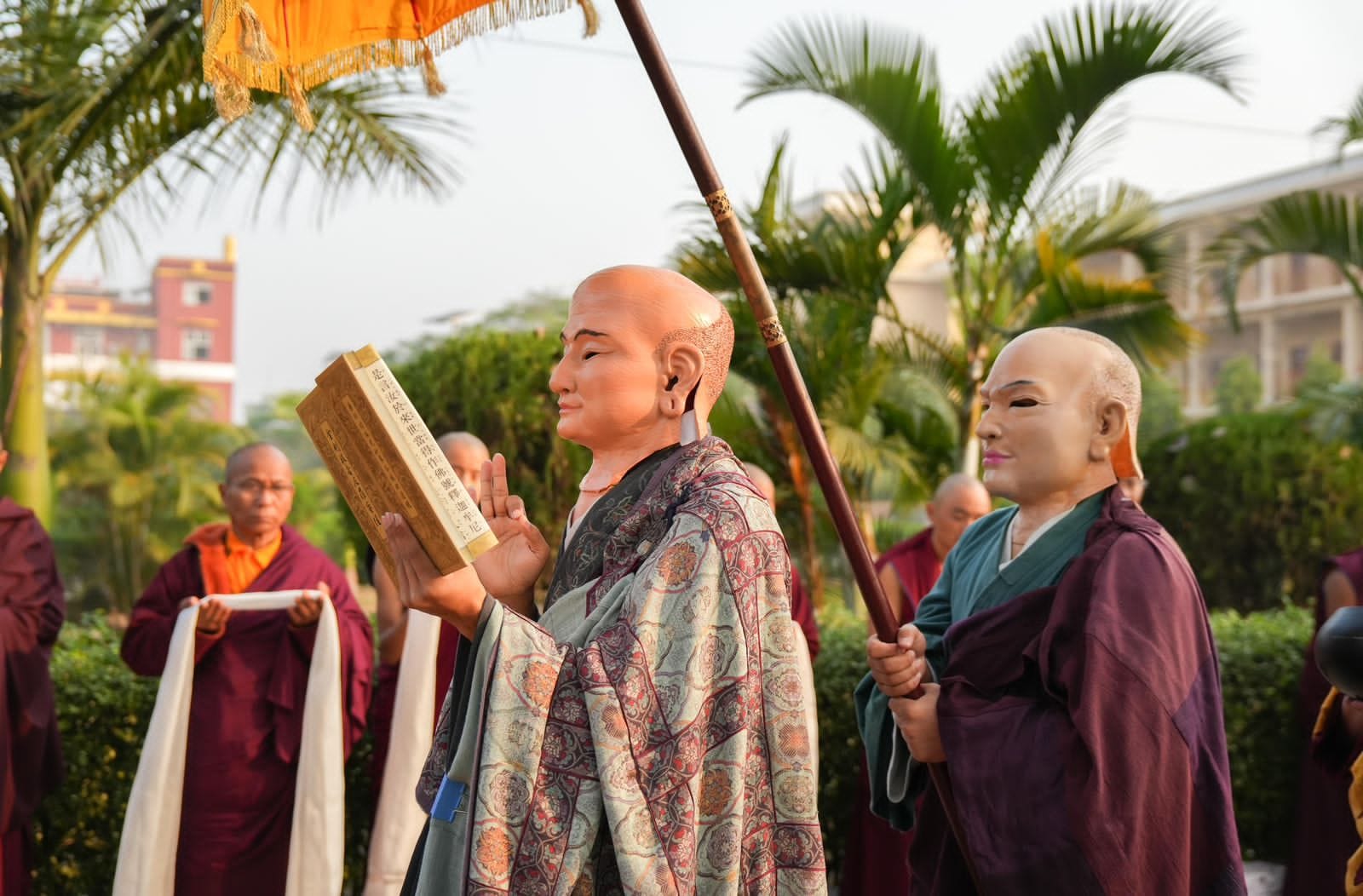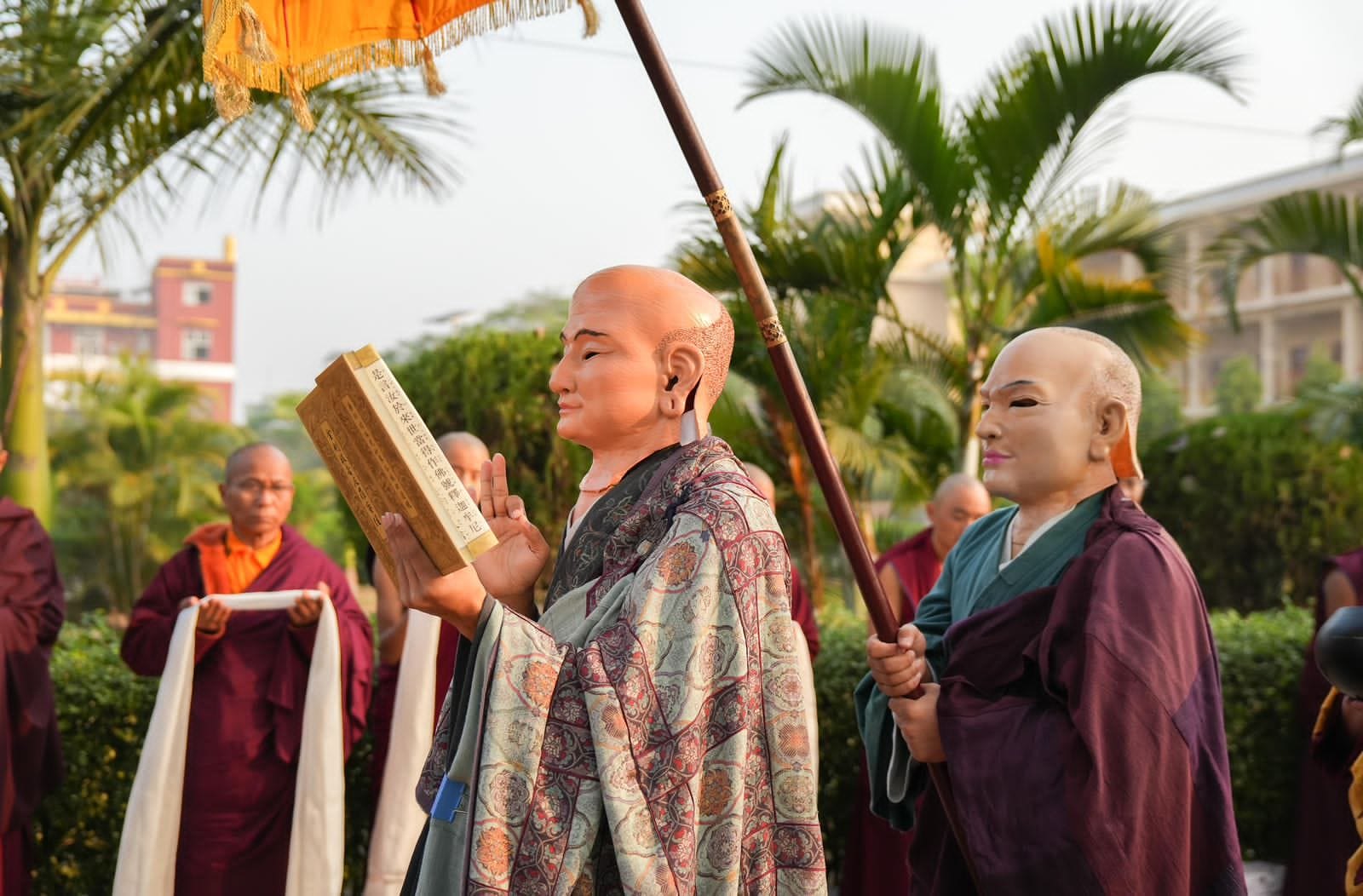Special Kagyu Monlam Day 6
3 February 2023
The day began with Mahayana Sojong in the main shrine hall with Khenchen Lodoe Donyo Rinpoche. After Sojong, a few monks remained to recite the Sanskrit prayers of the first session of the Monlam while the rest went outside to greet the procession.
Magnificent in their brocaded costumes and accompanied by their attendants, the Sixteen Arhats processed around the grounds of Bokar Obar Chimey Ling. Arhat Angaja, holding a small incense burner, led the procession, and each of the Arhats that followed could be identified by the accoutrements they carried and the number of their attendants. The procession culminated in the palanquin bearing the seated Golden Buddha under the golden parasol of royalty.
Victory banners and monks bearing alms bowls preceded them. The path of the procession was strewn with yellow flower petals. It wove through the grounds of the monastery, the bright colours of costumes and parasols contrasting vividly with the green of the palm fronds and the ashoka trees which line the paths. The approach to the shrine hall was the most ornately decorated, lined with garlands of marigolds and decorated with auspicious symbols. Monks and laypeople stood on either side of the path, holding katags and bowing in respect.
These sixteen Arhats [Tib. Neten Chudruk] were chosen by Shakyamuni Buddha from his disciples. They vowed to remain in the world in order to protect the Buddhadharma for as long as beings were capable of benefitting from the teachings, until the teachings came to an end at the appearance of the next World Buddha.
Finally, the procession entered the shrine hall, welcomed by a fanfare of gyalings and the ringing of a bell. The arhats took their seats on the stage, and the palanquin of the Golden Buddha was placed centrally on a plinth. The congregation sang the Prostrations and Offerings to the Sixteen Elders, which names every Arhat individually and lists their accoutrements and attendants. Khenchen Lodoe Donyo Rinpoche and Bokar Rinpoche were the first to make offerings of great baskets of fruit. They were followed by monks carrying more baskets of fruit. After the monks, a long line of laypeople came forward to make offerings which were collected in a massive bowl in front of the stage.
After the conclusion of the morning session, the Arhats, as is customary, ate their lunch with the gelongs and Bokar Rinpoche in the special dining area reserved for gelongs.
The Arhat procession is another Kamtsang tradition revived by the Seventeenth Karmapa and has its origins in a procession of the arhats in costume, that was first held in the Great Encampment on the final day of the Monlam Chenmo during the time of the Seventh Karmapa. The Ninth Karmapa added the Golden Buddha, and the tradition of the procession continued until the time of the Tenth Karmapa when the Great Encampment was destroyed during the Tibetan civil war. Later, during the time of the Fifteenth and Sixteenth Karmapas, the traditional procession was restored as part of the Month of Miracles and was held on the full-moon day in the first month of the Tibetan year. Initially, there was no Sixteen Arhat procession at the Kagyu Monlam Chenmo in Bodhgaya, until 2014, when the Karmapa introduced the Arhats into the annual Monlam Alms Procession. At that time, he explained:
We’re inviting the Arhats to join…mainly in order to help the Dharma flourish. The Dharma teachings are the sole medicine, the sole salve for all sentient beings. It’s the only medicine to eliminate the sufferings of sentient beings.
The costumes and masks the Arhats wore were those commissioned for the Kagyu Monlam Chenmo in Bodhgaya and brought specially from the Kagyu Monlam storage in Bodhgaya. Their features and the style of their robes reflect the Chinese tradition of the Arhats which was introduced into Tibet at the time of the restoration of Buddhism in the 10th century. The special palanquin for the Golden Buddha was constructed on-site at Bokar Shedra.
Further information on the Arhats Procession and the individual Arhats can be found at:
Click on the photo to view Flickr picture gallery ↓



































